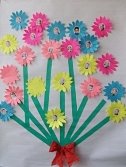Методичні рекомендації "How Can Teachers Generate Motivation in Young Learners to Study English at the Beginning of the Year?"
How Can Teachers Generate Motivation in Young Learners to Study English at the Beginning of the Year?
It’s important to welcome students and make them feel comfortable as soon as they step foot into the classroom. School is a place where students spend the majority of their day so it should feel like their second home. Here are some ideas to welcome students back to school after a long summer break.
Create an Inviting Classroom
One of the easiest ways to welcome students is to create an inviting classroom. This is a place where students are going to spend six hours a day, five days a week. So, our classrooms should feel warm and inviting from the first second they enter the door. A great way for students to feel like their classroom is "theirs" is to have them help you decorate it and add their own personal touch. During the first weeks back to school, teachers should encourage students to create drawings and projects that can be displayed in the classroom.
“A Special Bunch”

During the first couple days of school, a teacher can take each child's photo, cut the child's face out in the shape of a circle and then stimulate students make flower patterns out of color papers. They can also write their names in the petals. Students will then glue their photo in the center of their flower. Finally, a teacher uses green paper to create the stems, and a color of your choice to create the ribbon.
“I Am Special”
 This is a great activity and display for the beginning of the year, or any other time that you would like to focus on unique qualities of individual students. It's a fun activity that allows you to introduce and/or practice quotation marks with your students. Make a class set of a basic person shape. Students then decorate and cut out their shape. Students write their own sentence explaining why they are special. For example, "I am special because I can ride my bike and climb a tree." Having a parent volunteer available to type the statements would be great. After printing, students cut out their statement and glue it to a piece of construction paper that resembles speech bubble.
This is a great activity and display for the beginning of the year, or any other time that you would like to focus on unique qualities of individual students. It's a fun activity that allows you to introduce and/or practice quotation marks with your students. Make a class set of a basic person shape. Students then decorate and cut out their shape. Students write their own sentence explaining why they are special. For example, "I am special because I can ride my bike and climb a tree." Having a parent volunteer available to type the statements would be great. After printing, students cut out their statement and glue it to a piece of construction paper that resembles speech bubble.
“What Is Your Name?”
 In order to help students to remember their names it’s good to make a project “What is your name?” Make a class set of a basic students’ hands shape. Then ask your students to write their names on the shapes. After that glue each hand on a yellow circle and create your class hand-name sun.
In order to help students to remember their names it’s good to make a project “What is your name?” Make a class set of a basic students’ hands shape. Then ask your students to write their names on the shapes. After that glue each hand on a yellow circle and create your class hand-name sun.
Back-to-School "Recipe for a Great School Year"

A teacher cuts out a giant recipe card and put the title "Recipe for a Great School Year" in the upper top of the poster. Then write "Ingredients" and list the kid's names. After that write "Directions" and add your part about one cup cooperation etc...
“A Tree of Our Dreams”

A teacher paints a tree and prepares stickers in the shape of flowers, leaves or apples. In the lesson ask your students write their wishes and dreams for the following year. Then create a kind of “A Tree of Our Dreams”
A positive "psychological environment"
A positive "psychological environment" strongly influences student motivation too. School teachers can create this type of environment by establishing policies and programs that:
- stress goal setting and self-regulation/management
- offer students choices in instructional settings
- reward students for attaining "personal best" goals
- foster teamwork through group learning and problem-solving experiences
- replace social comparisons of achievement with self-assessment and evaluation techniques
- teach time management skills and offer self-paced instruction when possible
Individual goal-setting structures allow students to define their own criteria for success.
Outcome-based instruction and evaluation make it possible for slower students to experience success without having to compete with faster students. Attribution retraining can help apathetic students view failure as a lack of effort rather than a lack of ability. Cooperative learning activities help students realize that personal effort can contribute to group as well as individual goals.
Teachers use a variety of methods to teach English as a second language. Each student is unique and will respond well to a particular method. ... Adapting your style to your class can be an effective teaching method.
Games can increase English knowledge while keeping students interested in the class. With young students, you may want to try games that are active, such as throwing an object to hit a vocabulary card and having them use that word in a sentence. You can also use quieter games, such as Bingo or word puzzles.
A Warm-up Game
Games such as charades are good in developing your class's interest and talent in drama. You could have your class play it in a substitute period. Divide the class into teams. Each team, usually after a collective discussion, gives one member of the other team who has volunteered to mime (some action, Christmas items). Only one member of the team is shown the name and he or she has to mime it without mouthing any of the words for his own team members who have to guess it. If they guess it correctly within the stipulated time period (three to five minutes) they win a point. This game is going to tell you a lot about your students. It will also loosen up the atmosphere of your class and prepare you and your students for doing drama.
Visual Aids
Visual aids such as flash cards can help quickly build vocabulary. For example, you may go through a stack of flash cards to teach new words, then use those words in a game. Without the cards, students may not know what you are talking about. You can also use visual aids such as English movies or TV shows to teach the students about American culture.
Role-playing
Conversational practice is key to improving students' English abilities. Set the students up in different scenarios, such as meeting a new friend, describing a new toy of a student to his/her friends, and have the students role-play the conversation. You could have students practice with you or with one another.


про публікацію авторської розробки
Додати розробку
